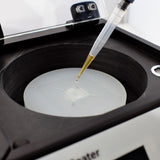PEDOT:PSS Electrodes

The choice of electrode is very important in many optoelectronic devices. Solar cells, LEDs and photodetectors all need an electrode on either side of the device. These electrodes should meet the following criteria.
- Both should have low sheet resistance, to ensure efficient transfer of electrons from the device.
- At least one electrode must be transparent, allowing light to be transmitted into or out of the active layer.
Glass substrates coated with a transparent conductive material are a popular choice for the transparent electrode. In most cases, this conductive coating on the glass is formed of indium tin oxide (ITO), fluorine tin oxide (FTO) or other transparent conductive oxide (TCO). This TCO layer is combined with a thin metal layer used as the counter electrode.
It is possible to replace either of these layers with PEDOT:PSS electrodes. This is especially appealing for flexible substrates, due to the mechanical flexibility of PEDOT:PSS.
PEDOT:PSS as Bottom Electrode
ITO-coated glass is usually processed at high temperatures (i.e. using sputter coating systems). Therefore, ITO coating is not possible for many flexible electronics. Additionally, there is concern about using ITO in sustainable technologies due to its limited global supply. Therefore, some people want to use more sustainable electrodes.
PEDOT:PSS is a great choice of electrode for flexible PV devices due to its mechanical flexibility, combined with its relatively low sheet resistance, high stability and optical transparency.
However, PEDOT:PSS has relatively low conductivity compared to ITO layers. Also, ITO is more stable in a device than PEDOT:PSS layers. This can impact device stability. These problems need to be addressed in order for PEDOT:PSS electrodes to achieve their full potential.
PEDOT:PSS as Top Electrode
Thermal evaporation of metal electrodes requires high-vacuum systems and complex deposition techniques. These methods can be expensive and energy consuming. Additionally, evaporating metals onto your device can cause damage to sensitive layers underneath. This makes solution processed top electrodes an attractive prospect.
Also, if you are using opaque substrates, such as carbon fiber or silicon, then you will need a transparent top electrode. For this, polymers can be a more reliable alternative to extremely thin metal films. Highly conductive PEDOT:PSS layers could act as this transparent, solution processible top electrode.
However, there are some issues with using PEDOT:PSS as a top electrode:
- PEDOT:PSS solution is hard to wet on hydrophobic lower layers.
- PEDOT:PSS layers are easy to penetrate or damage due to being thin and flexible.
- Their hydrophilic nature can lead to moisture penetration into your device.
PEDOT:PSS Electrodes in Devices
- Photovoltaic devices using PEDOT:PSS as the bottom electrode have achieved device efficiency over 10% PCE on both rigid and flexible substrates. Similar organic photovoltaics have achieved PCE's of over 7%.
- OPVs with PCE's of > 6% have been achieved using PEDOT:PSS as both a top and bottom electrode. These proves that "all plastic" metal-free solar cells are possible in the future.
PEDOT Polymer Blends

Learn More
PEDOT synthesis involves the oxidative chemical or electrochemical polymerization of EDOT monomer. The choice of counterions and polymerization method significantly affects the conductivity, work function, and stability of the resulting PEDOT polymer.
Read more... How to Spin Coat PEDOT:PSS
How to Spin Coat PEDOT:PSS
A huge advantage of LED and OLED is their ability to produce luminescence without producing heat. But what are the main differences between LED and OLED?
Read more... PEDOT:PSS Conductive Polymer
PEDOT:PSS Conductive Polymer
PEDOT:PSS is a blend of two distinct polymers: poly(3,4-ethylenedioxythiophene) (PEDOT) and polystyrene sulfonate (PSS). This combination forms a p-type semiconductor which is highly valued for its ability to conduct electricity and its ease of processibility.
Read more...References
- Reza, K. M., Mabrouk, S., & Qiao, Q. (2018). A review on tailoring PEDOT:PSS Layer for improved performance of Perovskite Solar Cells. Proceedings of the Nature Research Society, 2. https://doi.org/10.11605/j.pnrs.201802004
- Hu, L., Song, J., Yin, X., Su, Z., & Li, Z. (2020). Research progress on polymer solar cells based on PEDOT:PSS Electrodes. Polymers, 12(1), 145. https://doi.org/10.3390/polym12010145
- Xia, Y., Yan, G., & Lin, J. (2021). Review on tailoring PEDOT:PSS layer for improved device stability of perovskite solar cells. Nanomaterials, 11(11), 3119. https://doi.org/10.3390/nano11113119
Contributing Authors
Reviewed and edited by
Application Scientist
Diagram by
Graphic Designer